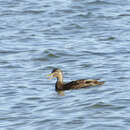en
names in breadcrumbs


At close range, the American Black Duck may be identified by its dark color, dull-yellow bill, and white under-wing patches. However, due to its large size (20-25 inches) and familiar oval-shaped body, the American Black Duck is often mistaken at a distance for the more ubiquitous Mallard (Anas platyrhynchos). Separating American Black Ducks from the Mallards has become increasingly difficult as Mallards have begun to interbreed with this species, producing hybrids with characteristics intermediate to those of the two parent species. Male and female pure-bred American Black Ducks are similar to one another in all seasons. The American Black Duck breeds across northeastern North America from the eastern edge of the Great Plains east to the Atlantic coast and from the Hudson Bay south to the Mid-Atlantic region. Northern populations migrate south in winter, when they may be found in the southeast and along the Ohio River Valley. Populations in the northeastern United States and in the Mid-Atlantic region migrate short distances (if at all), and this species may be found all year in these areas. American Black Ducks breed along lakes, streams, and in freshwater and saltwater marshes. Similar habitats are utilized by this species in winter. Most hybrids occur where appropriate habitats for American Black Ducks overlap with those of Mallards, especially in more built-up areas. Like the Mallard, this species is a generalist feeder, eating grasses and aquatic plants, seeds, grains, insects, mollusks, crustaceans, and fish. American Black Ducks are often found floating on the water’s surface, occasionally dabbling (submerging their head and chest while their legs and tail stick out of the water) to find food. These ducks are also capable of taking off directly from the water. They may also be found on land, where they may be observed walking, or in the air, where they may be observed making swift and direct flights between bodies of water. Small numbers of American Black Ducks may be looked for among larger flocks of Mallards. This species is most active during the day.